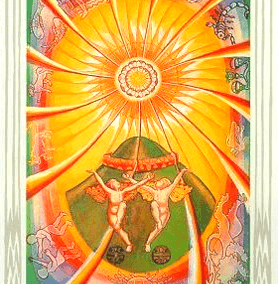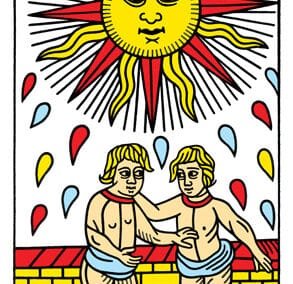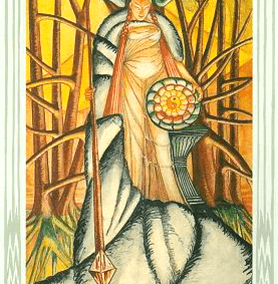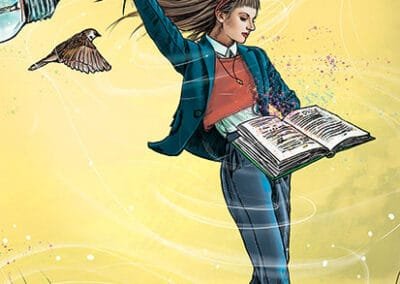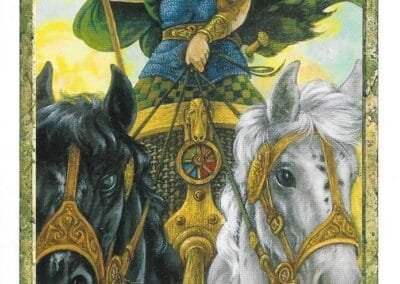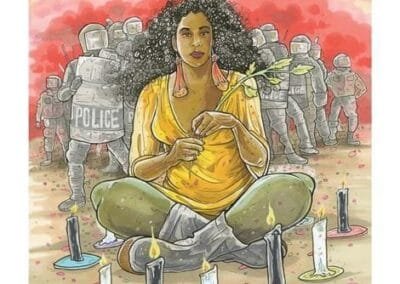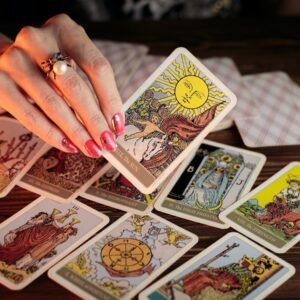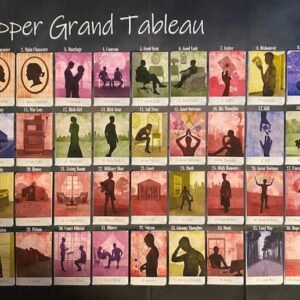Characters with Male and Female Genders in the Tarot Cards are quite common. For a long time, I thought that this was merely the creative decision of the Designer of that Tarot Deck. However, as I worked with the cards over the years, this perception has changed. Today, I would like to talk a little bit about the Masculine or Male and the Feminine or Female Gender Characters in the Tarot Cards and what they have come to mean for me.
All of this started, of course, with an email from one of the readers of my book. She found the presence of male and female gender characters in the Tarot card images confusing. She didn’t understand how the symbolism played into the interpretation of the card imagery. While she was focused more on the Major Arcana, I realized that this was true of the Minor Arcana and, of course, the Court Cards as well. While I briefly replied to her email, I decided to go deeper with a blog post.
Male and Female Genders in the Tarot Cards + in the World
Before We Proceed, A Bit of A Disclaimer, If You Will Indulge Me…
The concept of “gender“ has undergone quite a bit of change in the world we live in. While I don’t want to get into the controversial nature of that particular discussion, I would like to point out that in the Tarot, these are purely symbolic depictions! Male figures represent Masculine energies at play, and Female figures represent Feminine energies at play.
When we talk about either the Rider-Waite-Smith or the Thoth or the Marseilles Tarot Decks, we are talking about decks that were created in the early 1900s (for the Rider-Waite-Smith and Thoth) and the 1400s (for the Marseilles). So bear in mind that a lot of the depictions may not necessarily conform to modern norms. For instance, you may very well find more male figures than female figures in the card images. And you will also find less diverse characters, both in terms of race and body type. This may very well explain why several interesting new decks have become quite popular in recent times. But more on that later.
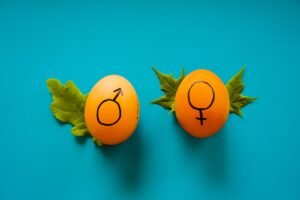
Photo by Dainis Graveris on Unsplash
Male and Female Genders in the Tarot Cards: What Is It All About?
As I said earlier, the Masculine or Male characters and the Feminine or Female characters in the Tarot Cards represent the Masculine and Feminine Energies of the card characters, respectively.
Masculine Energy
Typically, Masculine energy is said to be action-oriented, assertive, and logical or linear in their thinking pattern. The actions are outward oriented — focused on taking the energy and converting or using it in various aspects of the outer world that these characters live in. Masculine characters are direct in their approach and like to conquer the world they live in.
Feminine Energy
Conversely, the typical view of Feminine energy is that it is passive, nurturing, and emotional in its approach. The actions are inward-oriented — focused on taking the energy and converting or using it in various aspects of the inner world. The approach is receptive and focuses on integration. Feminine characters like to connect and create a harmonious world to live in.
 Masculine or Feminine: Which is Better?
Masculine or Feminine: Which is Better?
Honestly, that is a debate that no one has ever won! And I doubt we are going to find the solution in a blog post!
However, from the energetic and symbolic perspective, both are equal and opposite forces that are constantly at play in the Universe. They combine to create and disperse to destroy. This is an unending cycle that keeps the Universe going. From this standpoint, it makes sense to see that having both these energies in a balanced state would be the best for the World.
With these basics firmly in place, let’s now turn our attention to the images of the Tarot Cards. As we know, the Tarot Cards are divided into the Major Arcana and the Minor Arcana. However, for the purposes of this post, let’s also consider the Court Cards as another separate subset. Now, let’s look at the way the Male-Female, Masculine-Feminine story plays out in these cards.
Characters with Male and Female Genders in the Tarot Cards: Major Arcana
The Major Arcana Cards represent high-level energetic and archetypal energies that are at play in the Universe. The entire sequence of the cards from The Fool to The World shows the various steps in the Journey of a Dreamer, a Seeker who embarks on their journey of self-realization. Starting with taking the leap in The Fool card, all the way to attaining oneness with the Universe in The World card, each card shows us what the Seeker goes through at each point of revelation and understanding.
The Male or Masculine Gender characters in the Tarot cards show us that the situations depicted in the card images are handled in a very Masculine way -i.e., assertively and logically. Conversely, the Female or Feminine Gender characters in the Tarot cards show us that the situations depicted in the card images are handled in a very Feminine way -i.e., passively and with understanding.
In each card’s situation, either the Masculine and Feminine energies are necessary, or they are what is called upon because that is the best energy to use or to have while dealing with or going through the situations depicted in the card image. Let’s look at a few examples to clarify.

1: The Magician
The Magician
Male or Masculine Energy
This is the quintessential Masculine energy card. Look at the image! Here’s a table with a bunch of tools (each representing different energies), and you’re tasked with using those tools (and your knowledge, of course) to manifest something in the real world. In short, you have been given the necessary knowledge and the necessary tools to “make it happen”. Naturally, the male energies of linear thinking and action are called upon to make this happen. And, of course, we see the very masculine figure of The Magician standing there, doing his thing.
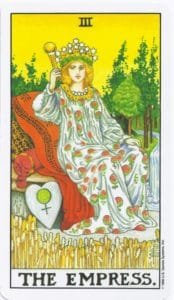
3: The Empress
The Empress
Female or Feminine Energy
This is a card so full of Feminine energy! Often, the card will depict a pregnant woman seated amongst flowering trees and growing crops and a stream of flowing water. If you are called upon to create something using yourself as the seed and source of nurturing, then you need to bring the Mother energy of The Empress into play. She bears a child from her own body, nurturing it and protecting it within herself and with her own energy. She connects with Nature and the cycles of Nature and brings about harmony in the World.
For now, these examples should suffice to understand how the specific energy is just right for handling the situations depicted in those cards. I am already thinking of writing more posts where I dig deep into each of the Major Arcana in this manner. So don’t worry, I should have those blog posts out soon!
Characters with Male and Female Genders in the Tarot Cards: Minor Arcana
People are present on the card images of the Minor Arcana as well. They are doing something or going through something. And either masculine or feminine energy is being called upon to deal with the scenario. Let’s look at a couple of examples.

6 of Wands
6 of Wands
Male Energy in a Masculine Suit
Here we see a young man seated atop a horse, along with a group of people. All of them carry wands, which shows us that their desires and passions are driving them. But our main character has a very special wand. His wand is decorated with a laurel wreath — a symbol of success! In fact, he even wears a laurel wreath on his head. Thus, we can see that in order to take the passionate energies of other people, combine it with one’s own, and then lead them towards a particular goal, and that too successfully, will call upon the very Masculine traits of leadership and action.

9 of Pentacles
9 of Pentacles
Female Energy in a Feminine Suit
Here we see a young lady standing in her garden full of grape vines, enjoying a luxurious life. The bird on her hand symbolically depicts someone who likes to stay focused on long-term goals, and the snail crawling at her feet brings in the “slow and steady movement” energy into play. In order to enjoy a luxurious life without turning frivolous, and to ensure the consistent continuation of that luxury, calls the very Feminine traits of creativity, nurturing, and integration. All of this is further symbolized by the presence of the astrological glyph of Venus on her dress.
Masculine and Feminine Gender in the Tarot: Minor Arcana Suits
It is also interesting to note that each of the Four Suits is also connected with either Masculine or Feminine energy. The Suit of Wands and the Suit of Swords (with their very phallic suit symbols) are said to be Masculine, and the Suit of Cups and Suit of Pentacles are considered to be Feminine.
So it makes it that much more interesting to look at cards where the energies show up overlapping each other.

4 of Cups
4 of Cups
Masculine Energy in a Female Suit
In this card, we see a male figure sitting under a tree. His crossed hands and legs show a very passive, disinterested approach to the surroundings and situations within the card image. Although he seemingly has 3 Cups to choose from, all he does is imagine or desire the 4th Cup. Although a male figure, he is passive and emotional in his approach towards the offered Cups (containers for his emotions). In that, he plays upon a typical masculine trope of rejecting all the emotion-based sources of sustenance for himself.

2 of Swords
2 of Swords
Feminine Energy in a Male Suit
In this card, we see a female figure who is blindfolded and sits on a bench, holding two swords in her hands. She has to choose from two different thinking patterns — what one would call a logic-based situation. However, she chooses to approach this intuitively and emotionally. She can’t or won’t see what lies ahead of her — and therefore, it won’t help or influence her decision. She has to choose purely based on what she feels from deep within herself. It is no wonder, then, that we also see the presence of a water body and a crescent moon — very feminine symbols of emotion and intuition — to represent the energies that she has to work with.
Characters with Male and Female Genders in Tarot: Court Cards
Now, let’s look at the Court Cards. Put quite simply, Court Cards are the people cards. They show people who are motivated by the basic energy of the Suit they belong to. Thus, Wands people are passionate and fiery. Cups people are emotional and go with the flow. Swords people are intellectual and sharp. And Pentacles people are practical and materialistic.
Of course, we have the Court Card hierarchy that depicts their levels of maturity. Pages are childish and young and act immaturely. Knights are a bit more grown-up and street-smart and are actively involved in creating their worlds. Queens bring in emotional intelligence and understanding along with a little more maturity. And the Kings are said to have complete control over their elemental energies while also being in charge of the situations they are in.
You can also learn more about Court Cards via my blog post series: Understanding the Court Cards, right here on this blog.
In the Rider-Waite-Smith deck, the Knights and Kings are men, while the Queens are women. The gender of the Page is often ambiguous. (We will talk about those kinds of cards in just a little bit.) If we see the situations that Knights and Kings find themselves in, as shown through their card images, we could say that their very masculine traits are called into play. Therefore, it makes sense to see a Knight take action to assert himself in the world and to see the King conquer, rule, and lead his world. Similarly, the Queen nurtures both the Knight and the King with her emotional essence, bringing much-needed harmony and gentleness to their world.
We see this play of energies across several cards. For example, the King of Wands is passionate and in charge of everything in his world. Like the Salamander by his feet, he survives the fiery, passionate world intact. In fact, he even wears a crown of flames quite nonchalantly. The Knight of Cups takes his emotions, cup in hand, and gently rides his horse toward his emotional fulfillment. Meanwhile, the Queen of Pentacles sits on her throne in a garden full of fruits and flowers, balanced between creation and nurturing of all practical and material matters.
We also see the interesting overlap of male and female energies in cards like the Queen of Wands and King of Cups, where opposing energies are juxtaposed against each other to create an interesting personality! The Queen of Wands is then shown sitting like a man, with her legs spread apart, and she actively pursues creative passion projects. And we see the King of Cups floating on the ocean on his throne, exerting control over the emotions and creative energies that surround him.
Tarot Cards with Both Male and Female Gender Characters
Of course, we have cards where both male and female characters are present! This only means that both masculine and feminine energies are called upon in the situations depicted in the card.
For instance, unless the Man and the Woman in The Lovers card connect with each other and come together, they cannot have any sort of relationship. Here, the Man acts upon his feelings while the Woman receives and nurtures those feelings. The same duo finds themselves trapped in the darkness of the material world, bound by the chains of their desires, in the image of The Devil card. Here, the man has grown a tail of fiery passion, and the woman’s tail of grapes shows her addiction to material luxuries.
We find such imagery within the images of the Minor Arcana as well. We find a couple holding hands and welcoming us to their celebration in the 4 of Wands. A couple meeting each other and connecting with each other in the 2 of Cups. A young man ferries a woman and a child across turbulent waters and to calmer shores in the 6 of Swords. And we also see a cripple man and a beggar woman being there for each other together in the cold snow of the 5 of Pentacles.
In each image, both the masculine and feminine energies have come into play. In the 4 of Wands, the man actively celebrates the victory, while the woman takes care of the guests at their party. In the 2 of Cups, the man brings his passions and the woman dreams of someday creating a loving home (seen in the distance) for both of them. In the 6 of Swords, while the man actively ferries the woman and the child, the woman receives his help while she looks for a calmer shore. Finally, in the 5 of Pentacles, the cripple man keeps moving forward without feeling lonely because he has the beggar woman to keep him company and to care for him even in the harsh environment.
Tarot Cards with Ambiguous Gendered or Hermaphrodite Characters
While we look at cards where the gender of the card character is clearly defined, we also run into cards where there is no gender that can be obviously perceived. These card characters’ genders have been drawn quite ambiguously. My take on this is that these characters mean to embody both male or masculine and female or feminine qualities together as one, in harmony. These characters show us what the union of the energies looks like. They could also be literal “wild card” cards — they could be either energy, male or female, and still work.
For instance, the child in The Sun card in the Rider-Waite-Smith deck could be either a boy or a girl. The card’s interpretation of enthusiasm, clarity, crossing boundaries, clarity, etc., all work regardless of the gender of the child. Whether the playfully active male energy is called upon or whether generous, creative female energy is called upon, the card’s energy works with either! It is quite interesting to note that prior to the Rider-Waite-Smith deck, the Sun card depicted two children: one boy and one girl.
Similarly, we see an ambiguous gender on the Page in the Rider-Waite-Smith deck. The Page could be either a boy or a girl. Since they are depicted quite young in age and maturity, there’s no clear way of knowing. This can be quite interesting, perhaps even deliberate. Since they are young and immature, their energies have not quite developed as much. And we can often see a messy combination of both male and female energies at play in each of the card images of the Pages.
The Page of Wands loves to show off his skills but can get upset and emotional if he isn’t appreciated. The Page of Cups is creative and intuitive, but he can also become manipulative and demanding when his emotions are thwarted. Meanwhile, the Page of Swords has way too many ideas, but he can become emotional and confused easily when information overwhelms him. And finally, the Page of Pentacles is gentle and studious but can become quite materialistic and petty when he is prevented from doing his own thing.
Again, it may be interesting to note that many Kabbala-based decks, like the Thoth Tarot deck, will often clarify the gender of the Page, and rename it as Princess. This way, we get a balanced Court card situation with two male and two female characters.
Distribution of Male and Female Characters within the Classic Tarot Card Deck Imagery
While I had this post swirling around in my head, I had an interesting conversation with a student of mine. I was teaching him how to read with the Tarot de Marseilles deck, and we were talking about the differences between the images of the Minor Arcana cards of that deck and the classic Rider-Waite-Smith deck. Long story short, I ended up going back to my Notion database of card meanings of each of these decks and decided to figure it out. Below is a table that shows how the male and female characters are distributed within the imagery of the classic 3 Tarot Card Decks, namely, the Tarot de Marseilles, the Rider-Waite-Smith, and the Thoth Tarot.
Male and Female Genders in the Tarot Cards
| Genders | Tarot de Marseilles | Rider-Waite-Smith | Thoth |
|---|---|---|---|
| Male | 20 | 44 | 16 |
| Female | 10 | 14 | 15 |
| Male & Female | 6 | 12 | 5 |
| Creatures (Animals, Birds etc) | 13 | 24 | 31 |
| None | 40 | 6 | 40 |
Isn’t that quite eye-opening?
The distribution of Masculine and Feminine imagery in the Tarot Cards, through the art of the time (when these decks were published), can also tell us a lot about the overall balance of the sexes within the cultures of the time. Since art emerges from the world around us, these can even be an interesting mirror of how each gender was considered and viewed and the role they were expected to play and often ended up playing.
When Tarot Card Deck Creators Change the Genders of Characters in the Cards
Ever since the Rider-Waite-Smith deck was published in 1910, a sort of mini-revolution took place in the Tarot world. Previous Tarot Card decks didn’t depict people on the Minor Arcana card images. But this deck was different. Not only did it feature people, but it also showed them doing stuff and going through situations. Naturally, this gave rise to so many different interpretations, and methods of interpreting the Tarot Card images. This also inspired many people to create Tarot Decks based around different themes that have images similar to the Rider-Waite-Smith Deck.
However, today we also find Tarot Card Decks that do not follow the gender rules laid down by the traditional Tarot Decks. We have decks like the Modern Witch Tarot Deck, which is full of female characters on almost all of the cards. I love this deck because it also features characters that are diverse in their skin color and body shape. Meanwhile, there are also Tarot decks like the Light Seer’s Tarot Deck, where we find a bit more balance in the number of men and women depicted on the cards. This also means that we end up seeing a female Knight or a male Page card. I can also recall the powerful imagery of the Next World Tarot Deck that includes diverse characters spanning genders, races, body types, and sexual orientations.
My take on this situation is that it is quite refreshing and promising. I do like to see the “traditional” imagery for its inherent wisdom and deep symbolism. I also know that those roots have sunk deep into the psyche of the modern Tarot practitioner. Ultimately, it is those roots that have given rise to these very modern and non-typical or non-traditional depictions of the card images. What these new and modern images depict is an evolution of thoughts, ideas, and processes that bring these old images into the modern world.
As a system full of images that speak volumes, the Tarot is a repository of Archetypes and subconscious imagery. When times change, and our understanding of the world evolves along with it, naturally, those imagery tropes will also change! These images, therefore, are a depiction of this change and growth.
-

The Magician (Modern Witch Tarot)
-

Page of Swords (Light Seer's Tarot)
-

The Chariot (Druidcraft Tarot)
-

7 of Wands (Next World Tarot)
This means that the modern Magician can be a lady and still take control of the situation, albeit with her deeply intuitive understanding of the interplay of the elemental forces at play, and “make it happen” on the material plane. This also means that the Page of Swords can be a young lady reading a book, holding light bulbs sparkling with inspiration. The Charioteer can be a woman using her feminine intelligence to navigate the opposing forces of the world’s horses. The 7 of Wands can be the image of a lady showing her courage to face off all odds in the form of a candle march protest.
Characters with Male and Female Genders in Tarot Card Images
What Do You Think?
Masculine and feminine gender characters in Tarot cards ultimately help bring the masculine and feminine energies into play, interacting with the situations depicted in the card images in their own specific manner. These energies come into play to create the necessary action or to develop the required understanding of the situation. Whether their depictions are traditional or modern, they essentially bring tremendous value to the Tarot card’s image and meaning. Be it male or female, the genders in the Tarot Card images can only help us understand the card story better.
What do you think? What is your take? Do you think masculine or male gender characters, and also feminine or female gender characters on Tarot cards add value to the card’s meaning and our overall understanding of the imagery? Do you have anything to add to the article? Please do share your thoughts in the comments section below! I would really love to hear what you have to say.
- Male and Female Genders in the Tarot Cards


 Masculine or Feminine: Which is Better?
Masculine or Feminine: Which is Better?











